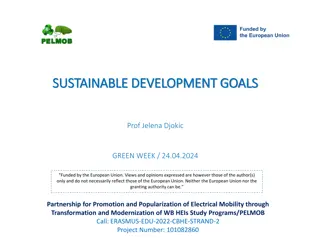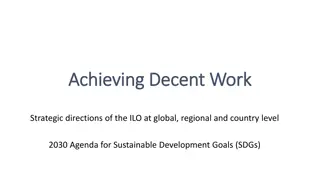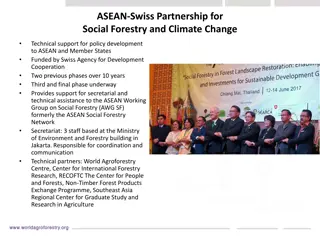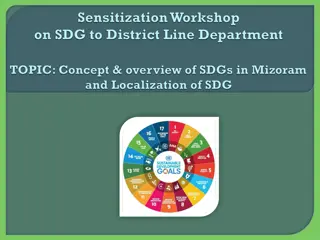Understanding the 2030 Agenda for Sustainable Development
The 2030 Agenda for Sustainable Development emphasizes the importance of not cherry-picking goals, but instead assessing interlinkages across targets. It consists of 17 goals addressing various global challenges such as poverty, inequality, gender equality, climate change, and sustainable development. The agenda promotes universality, integration, and the principle of leaving no one behind, focusing on synergy and balance among social, economic, and environmental dimensions. Data shows that vulnerable populations, especially women and girls in rural areas from poor families and minority ethnic groups, are at risk of being left behind.
Download Presentation

Please find below an Image/Link to download the presentation.
The content on the website is provided AS IS for your information and personal use only. It may not be sold, licensed, or shared on other websites without obtaining consent from the author. Download presentation by click this link. If you encounter any issues during the download, it is possible that the publisher has removed the file from their server.
E N D
Presentation Transcript
THE 2030 AGENDA - Reaching the most vulnerable families Douglas Webb HIV, Health and Development Group, UNDP, New York @DougUNDP 1
2030 AGENDA FOR SUSTAINABLE DEVELOPMENT The 2030 Agenda is indivisible countries should avoid cherry picking goals. It is important to assess the interlinkages across goals and targets. The considered sweet spot areas are limited. Countries need to carefully assess the trade-offs across goals/targets. 2
SDGs - 17 goals, 169 targets: a Forest of Christmas trees Goal 1. End poverty in all its forms everywhere Goal 10. Reduce inequality within and among countries Goal 2. End hunger, achieve food security and improved nutrition, and promote sustainable agriculture Goal 11. Make cities and human settlements inclusive, safe, resilient and sustainable Goal 3. Ensure healthy lives and promote well-being for all at all ages Goal 12. Ensure sustainable consumption and production patterns Goal 4. Ensure inclusive and equitable quality education and promote life-long learning opportunities for all Goal 13. Take urgent action to combat climate change and its impacts Goal 5. Achieve gender equality and empower all women and girls Goal 14. Conserve and sustainably use the oceans, seas and marine resources for sustainable development Goal 6. Ensure availability and sustainable management of water and sanitation for all Goal 15. Protect, restore and promote sustainable use of terrestrial ecosystems, sustainably manage forests, combat desertification, and halt and reverse land degradation and halt biodiversity loss Goal 7. Ensure access to affordable, reliable, sustainable, and modern energy for all Goal 16. Promote peaceful and inclusive societies for sustainable development, provide access to justice for all and build effective, accountable and inclusive institutions at all levels Goal 8. Promote sustained, inclusive and sustainable economic growth, full and productive employment and decent work for all Goal 17. Strengthen the means of implementation and revitalize the global partnership for sustainable development Goal 9. Build resilient infrastructure, promote inclusive and sustainable industrialization and foster innovation
2030 AGENDA AND THE SDGS UNIVERSALITY INTEGRATION NO ONE LEFT BEHIND Implies that goals and targets are relevant to all governments and actors. Universality does not mean uniformity. It implies differentiation (What can each country contribute?) Policy integration means balancing all three SD dimensions: social, economic growth and environmental protection An integrated approach implies managing trade- offs and maximizing synergies across targets The principle of no one left behind advocates countries to go beyond averages. The SDGs should benefit all eradicating poverty and reducing inequalities. Promotion and use of disaggregated data is key 4
Intersectionality Available data across 16 countries found that the most likely to be left behind are women and girls in rural areas who are born to poor families and belong to a minority ethnic group (ODI) This population has had the fewest years of education, the highest under-five child mortality rates and the least progress in human development over the last few decades. In this case, three factors intersect to generate reinforcing deprivations and disadvantages: geography (rural), socio-economic status (income poor families) and identity/discrimination (gender and ethnic minority)
Realizing the opportunity to leave no one behind To deliver on the commitment to the 2030 Agenda, countries should take an integrated approach, drawing on three mutually reinforcing levers to examine, empower and enact change: i) Examine: disaggregated and people driven data and information; ii) Empower: civic engagement and voice; and iii) Enact: integrated, equity-focused SDG policies, interventions and budgets. 2030 Agenda 2030 calls on all countries to identify who is left behind across income, gender, age, race, ethnicity, migratory status, disability and geographic location
Some questions Poverty is both a cause and consequence of poor health so Universal Health Coverage as a driver? What narrative should we use? universal, inequities, justice, human and health security, economic development, human capital Without explicitly changing course, the furthest behind are likely to continue to be locked out of global progress and unable to benefit from or participate in innovation, new technologies or the global economy.
THE 2030 AGENDA - Reaching the most vulnerable families Douglas Webb HIV, Health and Development Group, UNDP, New York @DougUNDP 11























